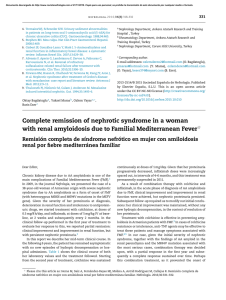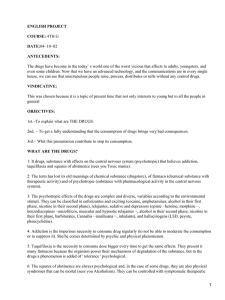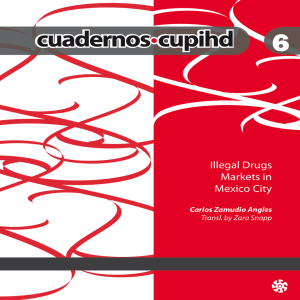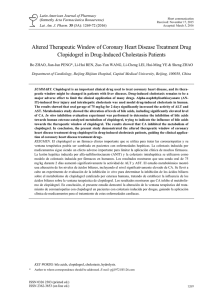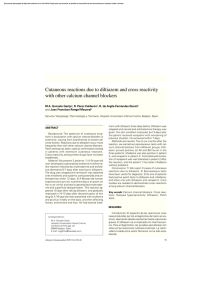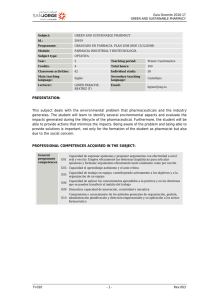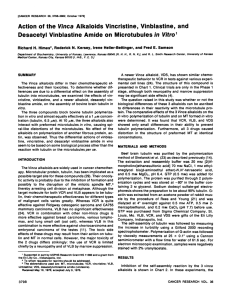Multidrug resistance increment in a human colon carcinoma cell line
Anuncio
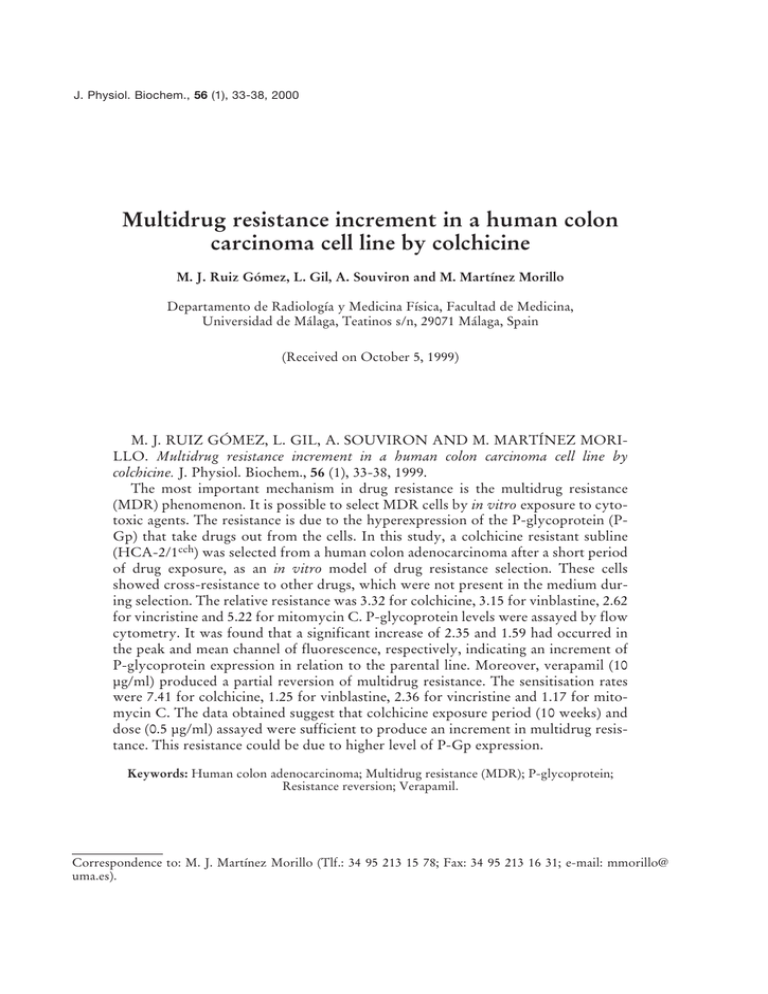
J. Physiol. Biochem., 56 (1), 33-38, 2000 Multidrug resistance increment in a human colon carcinoma cell line by colchicine M. J. Ruiz Gómez, L. Gil, A. Souviron and M. Martínez Morillo Departamento de Radiología y Medicina Física, Facultad de Medicina, Universidad de Málaga, Teatinos s/n, 29071 Málaga, Spain (Received on October 5, 1999) M. J. RUIZ GÓMEZ, L. GIL, A. SOUVIRON AND M. MARTÍNEZ MORILLO. Multidrug resistance increment in a human colon carcinoma cell line by colchicine. J. Physiol. Biochem., 56 (1), 33-38, 1999. The most important mechanism in drug resistance is the multidrug resistance (MDR) phenomenon. It is possible to select MDR cells by in vitro exposure to cytotoxic agents. The resistance is due to the hyperexpression of the P-glycoprotein (PGp) that take drugs out from the cells. In this study, a colchicine resistant subline (HCA-2/1cch) was selected from a human colon adenocarcinoma after a short period of drug exposure, as an in vitro model of drug resistance selection. These cells showed cross-resistance to other drugs, which were not present in the medium during selection. The relative resistance was 3.32 for colchicine, 3.15 for vinblastine, 2.62 for vincristine and 5.22 for mitomycin C. P-glycoprotein levels were assayed by flow cytometry. It was found that a significant increase of 2.35 and 1.59 had occurred in the peak and mean channel of fluorescence, respectively, indicating an increment of P-glycoprotein expression in relation to the parental line. Moreover, verapamil (10 µg/ml) produced a partial reversion of multidrug resistance. The sensitisation rates were 7.41 for colchicine, 1.25 for vinblastine, 2.36 for vincristine and 1.17 for mitomycin C. The data obtained suggest that colchicine exposure period (10 weeks) and dose (0.5 µg/ml) assayed were sufficient to produce an increment in multidrug resistance. This resistance could be due to higher level of P-Gp expression. Keywords: Human colon adenocarcinoma; Multidrug resistance (MDR); P-glycoprotein; Resistance reversion; Verapamil. Correspondence to: M. J. Martínez Morillo (Tlf.: 34 95 213 15 78; Fax: 34 95 213 16 31; e-mail: mmorillo@ uma.es). 34 MULTIDRUG RESISTANCE INCREMENT The main cause of chemotherapy failure is the development of resistance to antineoplasic drugs (9). Tumour cells resistant to drugs such as colchicine, vincristine, vinblastine or doxorubicin (11) have shown that the reason for this resistance is the hyperexpression of a membrane glycoprotein, named P-glycoprotein (P-Gp) or P-170, that acts as a drugs extracting pump (4). This phenomenon is known as multidrug resistance or MDR phenotype. During recent years, several mechanisms of multidrug resistance have been identified in cell lines cultured in vitro. There is a great relationship between PGp expression and the development of resistance to chemotherapy (17). The MDR phenotype is characterised by (19) cross-resistance to unrelated drugs, hyperexpression of P-Gp which contributes to a smaller drug accumulation in cells and partial reversal of drug resistance when exposed to verapamil. During the exposure of a cell population to a given drug dose, sensitive cells die, thus allowing the growth and adaptation of resistant cells (8). The cells of a population can show heterogeneous characteristics, although they originate from the same stem cell. The purpose of this study was to investigate whether a short period of colchicine exposure produces an adaptation of a human colon adenocarcinoma cell line that involves an increment in drugs crossresistance and P-Gp expression for the purpose of developing an in vitro model that would be relevant to the study of cancer cell chemoresistance. Materials and Methods Drugs used were colchicine (CCH) (MERCK, Darmstadt), mitomycin C J. Physiol. Biochem., 56 (1), 2000 (MMC) (INIBSA, Barcelona), vincristine sulphate (VCR) (LILLY, Madrid) and vinblastine sulphate (VBL) (LILLY, Madrid). Stocks were prepared with sterile distilled water (1 mg/ml), filtered by 0.22 µm and aliquots were frozen at –20 °C untill they were used. Verapamil (VRP) (KNOLL AG, Ludwigshafen) was dissolved in Dulbecco’s phosphate buffer saline (PBS) (1 mg/ml), filtered by 0.22 µm and frozen at –20 °C. Drugs and verapamil were diluted in sterile PBS for their use in the experiment. Human colon adenocarcinoma cells (HCA) (12) were grown in RPMI-1640 medium (with L-glutamine, calcium and magnesium free) and supplemented with Hepes buffer 1 M (15 ml/l), sodium bicarbonate 7.5 % (28 ml/l), 10 % heat inactivated calf serum and 1 % antibioticantimycotic solution 100 X (PSF, Gibco); at 37 °C in 5 % CO2/air atmosphere. A colchicine-resistant subline was obtained by continuous exposure of exponentially growing cell cultures to CCH (0.5 µg/ml). 5 x 105 cells were seeded in flasks falcon in a medium containing the drug and were subcultured when necessary. After 10 weeks (3), cells were exposed to 1 µg/ml of CCH and then maintained in exponentially growing culture. The selected cells, named HCA2/1cch, were grown in RPMI-1640 medium supplemented as described above and with the addition of colchicine (1 µg/ml) to avoid reversion of resistance. These cells grew in monolayer and were subcultured using trypsin (0.05 %) and EDTA (0.02 %) in Dulbecco’s phosphatebuffered saline (PBS). P-Gp expression was determined by flow cytometry (FACScan, Beckton Dickinson), performing the analyses on cells methanol-fixed (70 %); labelled with JSB-1 monoclonal antibody (Sera-Lab) P- M. J. RUIZ-GÓMEZ, L. GIL, A. SOUVIRON AND M. MARTÍNEZ MORILLO Gp (170 kDa) specific (1/25 dilution) and a secondary antibody fluorescein isothiocyanate (FITC)-conjugated goat antimouse IgG (Sigma) (1/50 dilution) (1). Monolayer clonogenic assays were used to study antineoplasic drug effect on cellular survival. The cytotoxicity of these drugs was calculated as the ratio of the survival rate of the culture treated with the antineoplasic agent and the survival rate obtained in non-treated controls. The result was expressed as the surviving fraction, extrapolating from these data the ID50 value, by means of lineal regression (3). 300 cells were seeded per Petri dish (60 mm Ø) in 5 ml of medium. The following day, they were exposed to different doses of drug during 1 hour and then, they were incubated during 7-10 days in 5 ml of drug free medium until colony formation (13). Colonies were stained with methylene blue (2 %) and methanol (75 %) in distilled water. The number of colonies per Petri dish was determined and surviving fraction was calculated. The effect of verapamil on drug resistance reversion was performed by clonogenic assay, as describe above. HCA2/1cch cells were exposed to different drugs in the presence of verapamil (10 µg/ml) during 1 hour (8). Statistical analysis.– The normality of data were tested by the Wilk-Shapiro rankit-plot approximation test, analysing them with the Student’s t-test; taking signification levels of 95 % (p < 0.05) in all cases. Results and Discussion Table 1 shows the greater resistance of the selected subline (HCA-2/1cch) to colchicine in relation to the parental cell line (HCA), as indicated by the ID50 valJ. Physiol. Biochem., 56 (1), 2000 35 ues (8). The response of HCA and HCA2/1cch cell lines to other drugs such as vinblastine (VBL), vincristine (VCR) and mitomycin C (MMC), not present in the culture medium during the selection, was tested. HCA-2/1cch showed cross-resistance to these drugs. The ID50 values obtained were 3.26 µg/ml for VBL, 15.68 µg/ml for VCR and 2.79 µg/ml for MMC, higher than that corresponding to the HCA cell line (relative increment of 3.15, 2.62 and 5.22 respectively, table 1). Both HCA and HCA-2/1cch expressed P-glycoprotein in their cell membranes. The P-Gp mean level increased from channel 61.72 (HCA) to channel 98.17 (HCA-2/1cch) and the peak fluorescence channel increased from 33.37 (HCA) to 78.43 (HCA-2/1cch). The response of the selected subline (HCA-2/1cch) to colchicine, vinblastine, vincristine and mitomycin C when exposed to verapamil (10 µg/ml) (8) was tested. Table 2 shows that ID50 value decreased when verapamil was added together with the drug in all the cases. The highest relative sensitisation rate was 7.41, obtained for colchicine, the drug present during the selection process. For the rest of the drugs, much lower values were obtained: 1.25 for vinblastine, 2.36 for vincristine and 1.17 for mitomycin C (table 2). Attempts to study drug resistance in vitro have focused on continuous exposure of colon adenocarcinoma cells (HCA) to colchicine. After 10 weeks, the selected cell line (HCA-2/1cch) was found to be resistant to this drug. The relative resistance obtained was similar to the levels obtained by RIMET et al. (16) on the human colon carcinoma cell line HT29D4 (3- to 15-fold), which was made multidrug resistant by transfection with a human MDR1 cDNA from the pHaM- 36 MULTIDRUG RESISTANCE INCREMENT Table 1. Cross-resistance to antineoplasic drugs and expression of P-glycoprotein in parenteral line of human colon adenocarcinoma (HCA) and in colchicine selected subline (HCA-2/1cch). ID50 (µg/ml) HCA HCA-2/1cch Relative increment P value (*) CCH VBL VCR 0.44 1.47 3.32 < 0.001 1.04 3.26 3.15 < 0.001 5.98 15.68 2.62 < 0.005 Fluorescence (P-Gp) MMC 0.53 2.79 5.22 < 0.001 Peak Channel 33.37 78.43 2.35 < 0.005 Mean Channel 61.72 98.17 1.59 < 0.05 (*) Student-t test. CCH: Colchicine. VBL: Vinblastine. VCR: Vincristine. MMC: Mitomycin C. P-Gp: P-glycoprotein. Table 2. Resistance reversion by verapamil (VRP) in colchicine selected subline (HCA-2/1cch). ID50 (µg/ml) –VRP Drug Colchicine Vinblastine Vincristine Mitomycin C 1.47 3.26 15.68 2.79 + VRP Sensitisation (10 µg/ml) rate 0.20** 2.60*** 6.65*** 2.38*** 7.41 1.25 2.36 1.17 Student-t test. **p < 0.005; ***p < 0.001. DR1/A expression vector and selection by colchicine. In this way, LEMONTT et al. (10) isolated resistant cells in a single step by using very low doses of CCH for a period of 6-8 weeks, obtaining a relative resistance of 3.9 The selected subline showed crossresistance to other drugs, which were not present in the selection medium. The highest levels usually correspond to the selection agent, although as in this case, the cross-resistance to mitomycin C is higher than that observed for colchicine (2). The levels of relative resistance obtained were very low in relation to those exhibited by other described MDR cell lines (43- to 1750-fold), selected with similar drug doses (7, 20, 14). J. Physiol. Biochem., 56 (1), 2000 The development of drug resistance was found to be associated to the higher expression of P-Gp, similar to the MDR human SCLC cells (18) and the CHRC5 MDR subline (6). Most of the strategies used to treat multidrug resistance associated to P-Gp involve the efflux inhibition provoked by this membrane pump (5, 16). VRP partially reversed resistance to vinblastine, vincristine and mitomycin C exhibited by HCA-2/1cch cells, obtaining a remarkably higher reversal for the selection drug. This could be due to the fact that colchicine has less affinity for P-Gp than the rest of the drugs which is why it might be recognised and transported out of cells less effectively (19). In other studies, verapamil favours the effect of cytotoxic drugs on murine lung carcinoma, melanoma and human colon adenocarcinoma (15). HÖLLT et al. (5) have found that incubation with 1 µg/ml VRP is sufficient to increase 13-18 times the cytotoxicity of VBL and other authors (19) state that VRP doses of 1.62 and 3.24 µg/ml produce a relative sensitisation rates from 1.4 to 7.5 for VCR and 1 to 8 for CCH. Chemosensitisation is a complex and multifactorial process, which could depend on the cytotoxic drugs, the type of sensitiser and the dose used, as well as on the quantity of P-Gp expressed by the cell line. M. J. RUIZ-GÓMEZ, L. GIL, A. SOUVIRON AND M. MARTÍNEZ MORILLO The data obtained in this work suggest that the colchicine exposure period (10 weeks) and dose (0.5 µg/ml) assayed were sufficient to produce an increment in multidrug resistance due to higher level of PGp expression on a human colon adenocarcinoma cell line, which might be useful to study cancer cell chemoresistance. 37 tirresistencia a fármacos, lo que podría ser debido a una mayor expresión de P-Gp. Palabras clave: Adenocarcinoma de colon humano; Multirresistencia a fármacos (MDR); GlicoproteínaP; Reversión de resistencia; Verapamil. References M. J. RUIZ GÓMEZ, L. GIL, A. SOUVIRON y M. MARTÍNEZ MORILLO. Incremento de la multirresistencia a fármacos en una línea celular de carcinoma de colon humano por colchicina. J. Physiol. Biochem., 56 (1), 33-38, 2000. El mecanismo más importante en la resistencia a fármacos es el fenómeno de multirresistencia (MDR). Es posible seleccionar células MDR por exposición in vitro a agentes citotóxicos. La resistencia se debe a la sobreexpresión de la glicoproteína-P (P-Gp), la cual disminuye la acumulación intracelular de fármacos. El objetivo de este estudio consiste en el desarrollo de un modelo de selección de resistencia a fármacos, por exposición de una línea celular de adenocarcinoma de colon humano a colchicina durante un corto período de tiempo. Las células seleccionadas (HCA2/1cch) muestran resistencia cruzada con otras sustancias no presentes en el medio durante la selección. El incremento relativo es de 3,32 para colchicina, 3,15 para vinblastina, 2,62 para vincristina y 5,22 para mitomicina C. Los niveles de P-Gp se determinan por citometría de flujo. Se observa un incremento de 2,35 y 1,59 en los canales pico y medio de fluorescencia, respectivamente, indicando un incremento de la expresión de P-Gp en relación con la línea parental. Además, el verapamil (10 µg/ml) produce una reversión parcial de la resistencia a múltiples fármacos. Las tasas de sensibilización son de 7,41 para colchicina, 1,25 para vinblastina, 2,36 para vincristina y 1,17 para mitomicina C. Los datos obtenidos sugieren que el período de exposición (10 semanas) y la dosis de colchicina empleada (0,5 µg/ml) son suficientes para producir un incremento en la mulJ. Physiol. Biochem., 56 (1), 2000 1. Arceci, R. J., Stieglitz, K., Bras, J., Schinkel, A., Baas, F. and Croop, J. (1993): Cancer Res., 53, 310-317. 2. Biedler, J. L. (1992): Cancer, 70, 1799-1809. 3. Boiocchi, M. and Toffoli, G. (1992): Eur. J. Cancer, 28, 1099-1105. 4. Brian, L. J., Dalton, W., Fisher, G. A. and Sikic, B. I. (1993): Cancer, 72, 3484-3488. 5. Höllt, V., Kouba, M., Dietel, M. and Vogt, G. (1992): Biochem. Pharmacol., 43, 2601-2608. 6. Kartner, N., Evernden-Porelle, D., Bradley, G. and Ling, V. (1985): Nature, 316, 820-823. 7. Kirschner, I. S., Greenberger, L. M., Hong Hsu, S. I., Huang Yang, C. P., Cohen, D., Piekarz, R. L., Castillo, G., Han, E. K.-H., Yu, L. and Horwitz, S.B. (1992): Biochem. Pharmacol., 43, 7787. 8. Komiyama, S., Matsui, K., Kudoh, S., Nogae, I., Kuratomi, Y., Saburi, Y., Asoh, K. I., Kohno, K. and Kuwano, M. (1989): Cancer, 63, 675-681. 9. LaQuaglia, M. P., Kopp, E.B., Spengler, B. A., Meyers, M. B. and Biedler, J. L. (1991): J. Pediatric Surgery, 26, 1107-1112. 10. Lemontt, J. F., Azzaria, M. and Gros, P. (1988): Cancer Res., 48, 6348-6353. 11. Ling, V. and Thompson, L. H. (1973): J. Cell Physiol., 83, 103-116. 12. Morales, J. A., Ruiz-Gomez, M. J., Gil-Carmona, L., Souviron, A. and Martínez-Morillo, M. (1995): Rev. esp. Fisiol., 51, 43-48. 13. Neale, M. L. and Matthews, M. (1989): Eur. J. Cancer Clin. Oncol., 25, 133-137. 14. NicAmhlaoibh, R., Heenan, M., Cleary, I., Touhey, S., Oloughlin, C., Daly, C., Nuñez, G., Scanlon, K. J. and Clynes, M. (1999): Int. J. Cancer, 82, 368-376. 15. Nygren, P. and Larsson, R. (1990): Bioscience Reports, 10, 231-237. 16. Rimet, O., Mirrione, A. and Barra, Y. (1999): Biochem. Biophys. Res. Commum., 259, 43-49. 17. Schneider, J., Efferth, T., Kaufmann, M., Matia, J. C., Mattern, J. and Rodríguez-Escudero, E. J. (1990): Cancer, 3, 202-205. 38 MULTIDRUG RESISTANCE INCREMENT 18. Shrivastava, P., Hanibuchi, M., Yano, S., Parajuli, P., Tsuruo, T. and Stone, S. (1998): Cancer Chemother. Pharmacol., 42, 483-490. 19. Twentyman, P. R., Reeve, J.G., Koch, G. and J. Physiol. Biochem., 56 (1), 2000 Wright, K.A. (1990): Br. J. Cancer, 62, 89-95. 20. Willingham, M. C., Cornwell, M. M., Cardarelli, C. O., Gottesman, M. M. and Pastan, I. (1986): Cancer Res., 46, 5941-5946.
